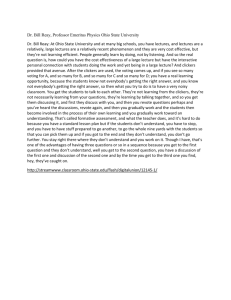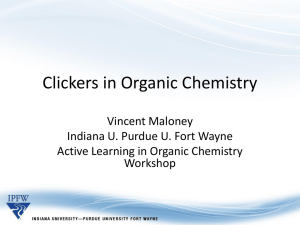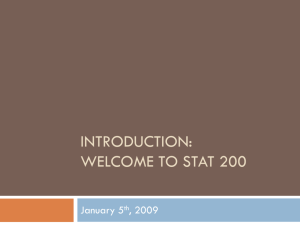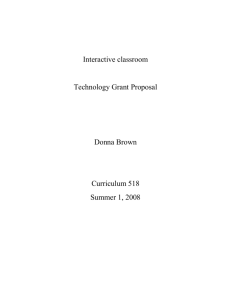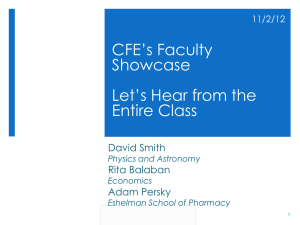How Do We Get Students Talking in First Year Courses
advertisement
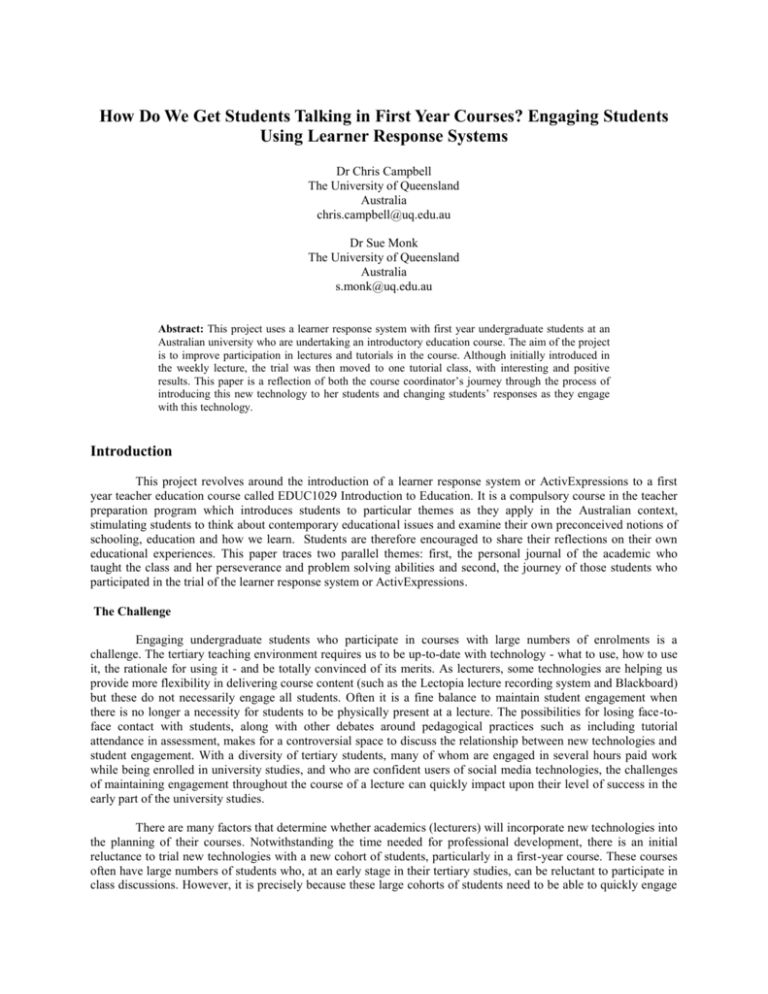
How Do We Get Students Talking in First Year Courses? Engaging Students Using Learner Response Systems Dr Chris Campbell The University of Queensland Australia chris.campbell@uq.edu.au Dr Sue Monk The University of Queensland Australia s.monk@uq.edu.au Abstract: This project uses a learner response system with first year undergraduate students at an Australian university who are undertaking an introductory education course. The aim of the project is to improve participation in lectures and tutorials in the course. Although initially introduced in the weekly lecture, the trial was then moved to one tutorial class, with interesting and positive results. This paper is a reflection of both the course coordinator’s journey through the process of introducing this new technology to her students and changing students’ responses as they engage with this technology. Introduction This project revolves around the introduction of a learner response system or ActivExpressions to a first year teacher education course called EDUC1029 Introduction to Education. It is a compulsory course in the teacher preparation program which introduces students to particular themes as they apply in the Australian context, stimulating students to think about contemporary educational issues and examine their own preconceived notions of schooling, education and how we learn. Students are therefore encouraged to share their reflections on their own educational experiences. This paper traces two parallel themes: first, the personal journal of the academic who taught the class and her perseverance and problem solving abilities and second, the journey of those students who participated in the trial of the learner response system or ActivExpressions. The Challenge Engaging undergraduate students who participate in courses with large numbers of enrolments is a challenge. The tertiary teaching environment requires us to be up-to-date with technology - what to use, how to use it, the rationale for using it - and be totally convinced of its merits. As lecturers, some technologies are helping us provide more flexibility in delivering course content (such as the Lectopia lecture recording system and Blackboard) but these do not necessarily engage all students. Often it is a fine balance to maintain student engagement when there is no longer a necessity for students to be physically present at a lecture. The possibilities for losing face-toface contact with students, along with other debates around pedagogical practices such as including tutorial attendance in assessment, makes for a controversial space to discuss the relationship between new technologies and student engagement. With a diversity of tertiary students, many of whom are engaged in several hours paid work while being enrolled in university studies, and who are confident users of social media technologies, the challenges of maintaining engagement throughout the course of a lecture can quickly impact upon their level of success in the early part of the university studies. There are many factors that determine whether academics (lecturers) will incorporate new technologies into the planning of their courses. Notwithstanding the time needed for professional development, there is an initial reluctance to trial new technologies with a new cohort of students, particularly in a first-year course. These courses often have large numbers of students who, at an early stage in their tertiary studies, can be reluctant to participate in class discussions. However, it is precisely because these large cohorts of students need to be able to quickly engage with both the course requirements as well as a new learning environment that there is an urgency to look for effective tools to enhance student participation. Another factor is the potential for new technologies to ‘fall over’ during lectures. As the academic relates in one of her journal entries: Although there was IT support during the lecture I was aware, nevertheless, of the potential scenario of having students watch as I fumble helplessly to ‘deliver content’, frustrated and explaining pointlessly ‘it was working this morning’!” So it was with a little trepidation that I participated in the trial of the ‘learner response system’. However, the challenge of having close to 200 students attending weekly lectures who could easily become just a sea of faces, or worse still, sit silently engaged with other social media technologies, counteracted this initial concern. The ‘learner response system’ (LRS) seemed to be one way to address this challenge and provide the opportunity to engage all of the students. This is explained further below. Related Literature There is quite a body of literature that surrounds the implementation and use of clickers in various higher education contexts (For example: Barnett, 2006; Caldwell, 2007; Hall, Collier, Thomas, & Hilgers, 2005; Koenig, 2010; Milner-Bolotin, Antimirova, & Petrov, 2010; Strasser, 2010). In a study of first year physics students, researchers defined clicker effectiveness “student perception of how much clicker pedagogy helped them stay engaged in class, understand the material, get continuous formative feedback on their progress, clarify difficult concepts, and reflect on their own learning” (Milner-Bolotin et al., 2010, p. 16). Caldwell (2007) suggests that clickers offer a flexibility in using clickers for learning as they can be used effectively in both lectures and tutorials and can be used with many different styles of questions. Trees and Jackson’s research of 1500 undergraduates enrolled in seven large courses across three university departments have been reported and they suggest that there are a number of factors contributing to student’s positive reception to using the clickers in class. These include the view that traditional lecture styles aren’t the best, a desire to be engaged and involved in the class, valuing feedback as well as previous experiences with lecture courses (Trees & Jackson, 2007). In an earlier study it was reported that one of the positives about students using the clickers is that they like receiving feedback on how well they actually understand the material they are learning. Students also reported enjoying the interactivity in class (Barnett, 2006). However, much of this literature focuses on the use of clickers in sciences where short-answer responses can help students and lecturers monitor progress. One study presents positive results in using clickers in teaching, although having to make significant changes to actual teaching to see these results (Kolikant, Drane, & Calkins, 2010). This study used clickers in undergraduate math and science classrooms in the USA and results suggest that the use of clickers doesn’t occur instantaneously in the classroom but is a gradual one where the instructors needed to overcome various challenges. However, the student suggests that the use of clickers “may act as a powerful catalyst to transform them, moving them from teacher-centered conceptions and approaches to teaching to student-centered conceptions and approaches” (Kolikant et al., 2010, p. 134). Another quantitative study on undergraduate Operations Management courses investigated how the use of clickers affected learning outcomes (Yourstone, Kraye, & Albaum, 2008). The results suggest that the use of clickers “can have an impact on student learning as measured by test scores” (Yourstone et al., 2008, p. 85). They go on to comment that it may not actually be the clicker technology that is responsible for the improved learning outcomes but the actual immediate feedback provided to the students through the use of the clickers. Methodology A case study methodology has been used for this project as it involves two academics, one coordinating and lecturing in the course and another supporting the use of the learner response system, and one cohort of students. The cohort of students was first year teacher education students studying in the course EDUC1029 Introduction to Education which involved a one hour lecture and one hour tutorial for 13 weeks. The trial initially began with the lecture and a computer software program called ActivEngage which the students could download onto their computers. It then moved to one tutorial class of 20 students, using ActivExpressions, a clicker type learner response system. This has been fully explained in the results section of this paper. The 20 students were surveyed at the end of their time using the ActivExpressions and with a combination of closed and open questions. Progress throughout this trial was recorded by the academic in the form of regular diary entries and contributes to the data included in this paper (presented as indented quotations). Results and Discussion The initial trial during a lecture met my worst fear, despite having support staff present. A collection of small incidents conspired against us, almost cementing my feelings of helplessness in the face of the onslaught of latest ‘gimmicks’ that seem to divert us from the actual task of teaching and learning. However, the following day, we quickly recovered: Plan B - A smaller trial with only one tutorial group and a smaller number of questions, the aim being that I become familiar and comfortable with the programme first so that I can stay focussed on the students. After the initial goals of investigating the use of the LRS with a large cohort of students some changes were made to the plan so that each week, with very small steps, we could use the ‘clickers’, monitor growing confidence for both students and teachers, and begin to see possibilities as they unfold. Initial observations were surprising: Many students were initially equally unsure about how to use the clickers, some expressing ‘not very confidant’ at the beginning of the tutorial to more students expressing ‘confident’ at the end of the session. This observation was worth recording because it revealed something that we have come to see very often over the past several years, that it is easy to assume that students, because of their youth, have a confidence and comfort with using all new technologies. The diversity of student backgrounds also includes a diverse range of individual student experiences using a range of technologies. The assumption that can easily be perceived by first-year students, that all students are equally comfortable with new technologies, can lead to a discomfort for some students who may prefer to remain quiet in their classes so that their ‘lack’ of IT skills remains unnoticed. The increase in student confidence was noted in feedback from student responses, with most students shifting quickly from “unsure” to “confident” or “very confident” in relation to using the LRS through the course of the trial. Students remained unidentified as they keyed in their responses to questions asked during the tutorials. In this context therefore, it appears that the use of clickers provided a safe space in which students could participate. In this way building student confidence was further enhanced because the lecturer was able to keep student responses anonymous, allowing them to express uncertainty about ideas contained in the course readings, or to express a different point of view, ensuring their participation. Over the course of several weeks, the lecturer was also developing her own level of confidence and skill. Today we kept right on time and everything worked well. I was able to pick up on some of the points students made and start discussions which responded more directly to what the students needed at the time. As the trial continued students also began to offer comments about their own learning. Since most of the tutorial discussion questions focussed on interpretations and responses to the weekly readings, it was essential that students prepared the readings before their class. As one student commented through the LRS , using the clickers to respond to the questions “did actually make me read the readings”. Moreover, the discussion could be guided according to the responses that were given. Using the LRS it was easy to see when students expressed similar concerns or questions. In other responses students commented The learner response system questions helped me to know how well I was learning the material. By using the learner response system in this class, I got feedback on my understanding of class material. Students also showed considerable interest in reading the responses by fellow students as they were displayed on the screen. This process allowed the tutor to immediately follow through with more in-depth discussions that could follow comfortably from a particular student response. We could give feedback almost immediately and everyone became aware that they had contributed to the ‘collection’ of ideas. In later weeks students were allocated a clicker number which enabled the lecturer to know who had responded to tutorial questions. This was a small shift, removing anonymity of students in relation to the lecturer’s knowledge of their responses, while still maintaining a degree of anonymity within the class as a whole. This small change nevertheless contributed to a much greater and more sophisticated engagement of students with the course material. It was encouraging to see a transition in students’ perceptions, as they not only responded positively in relation to the use of the clickers, but they also demonstrated an increasingly comfortable and sophisticated use of the clickers as they began to give more meaningful responses over the duration of the course. As the lecturer noted following this adjustment to monitoring students’ in-class clicker responses: Great responses today! It seems that students are over the initial novelty factor but not only that, they are offering some in-depth understandings of the readings that I don’t think they would have volunteered aloud. I am starting to get an understanding of how I might use these in-class responses and help students prepare for their written assignments (i.e. post them up on Blackboard so they can use them to help with their analysis). With the students’ growing comfort with using the clickers, and with their increasingly sophisticated responses to the course materials, we decided to post their responses to in-class discussions on the Blackboard site and we encouraged them to draw on these to help them with their written assessment pieces. It is often difficult for students to begin the analysis sections of their writing when they are alone away from their classes, but having the lists of ideas and discussion points that were collected through the use of the clickers, meant that students could recall the discussions with these prompts and build on work they had already started collectively. We were able to ask them specifically in class, using the clickers, if they had used these lists when they were preparing their written assessment tasks. We were pleasantly surprised to see that overwhelmingly students did refer to these recorded inclass responses. In relation to initial concern about whether the LRS system would lead to students engaging more with the course, perhaps what was interesting to note in student responses was less to do with attendance and more to do with the type of engagement. In the final questionnaire, most students agreed with the following statement that I thought about the questions posed carefully and seriously and thought about the answers before voting during the tutorials. In this respect, however, it was not simply a matter of student comfort and increasing skill in using the LRS, but with the lecturer’s ability to adapt her questions to the technology of the LRS itself. The greatest challenge with clickers was undoubtedly how to phrase questions that would allow students to demonstrate their understanding given that the type of questions most suited to the course focussed on open-ended high-order questions. Here is an example of one of the early tutorial questions formulated for easy response using the clickers. What do you think were the main challenges faced by the principals at the 3 schools mentioned in the article? The advantage of this type of question was that students could respond quite succinctly, however the limitations of eliciting mostly closed, low-order responses was not conducive to deep learning. The clickers, in essence, could only be used to provide brief responses. During the course of the trial, however, students began to increase their ability to provide succinct and more focussed responses while still giving meaningful responses that would simultaneously spark further class discussion. While it was encouraging to witness students demonstrating this increasing competence at expressing their ideas, it was paralleled by the lecturerer’s increasing ability to formulate appropriate questions that enabled students to give meaningful, yet succinct, responses. Later questions reflected the confidence in adapting appropriate questions with the technology, as discussion starters; Reflecting on the readings we have discussed and the lectures you have attended, how do you think the issues raised in this course relate to your own school experiences? or as a way if feeding into group discussions to analyze their weekly readings; How is parent participation a social justice issue? At the end of the trial both the cohort of student participants and the lecturer concluded with the clicker system was a valuable tool to use in tutorials. There were some comments by students who felt that they may not be effective for use in every tutorial due to the limitations of a one-hour tutorial and sometimes the dominance of these at the expense of group discussion. From the lecturer’s perspective, she felt more confident in using both the technology and the ability to adopt her teaching to a more engaging format for students that would ensure a higher degree of participation by all students. Conclusions In Milner-Bolotin et al’s (2010) results it was reported that students disliked losing marks for missing classes through an attendance/participation mark and although one can understand why students were not in favor of this it is one way to perhaps move forward with the use of learning response systems in tutorials. This study’s initial findings have demonstrated that not only attendance remained high in the tutorial group that were using the clickers, but also that students became more confident and thoughtful in relation to providing responses to questions during class discussions. Equally importantly, this small project provided an opportunity for a positive collaboration between an Educational Technology teacher and a social science teacher to bring about a useful and scaffolded incorporation of technology into tutorials. Having trialed the LRS on this small scale both academics look forward to extending the project with a larger cohort of students in 2012. This study concurs with the results from Trees and Jackson (2007) who found that a number of factors contribute to students’ positive perception of LRS. These include wanting to be engaged as well as involved in the class and valuing feedback. References Barnett, J. (2006). Implementation of personal response units in very large lecture classes: Student perceptions. Australasian Journal of Educational Technology, 22(4), 474-494. Caldwell, J. E. (2007). Clickers in the large classroom: current research and best-practice tips. CBE life sciences education, 6(1), 9-20. Hall, R. H., Collier, H. L., Thomas, M. L., & Hilgers, M. G. (2005). A Student Response System for Increasing Engagement, Motivation, and Learning in High Enrollment Lectures. Paper presented at the AMCIS 2005. Paper 255. http://aisel.aisnet.org/amcis2005/255 Koenig, K. (2010). Building acceptance for pedagogical reform through wide-scale implementation of clickers. Journal of College Science Teaching, 39(3), 46. Kolikant, Y. B.-D., Drane, D., & Calkins, S. (2010). “Clickers” as Catalysts for Transformation of Teachers. College Teaching, 58(4), 127 - 135. Milner-Bolotin, M., Antimirova, T., & Petrov, A. (2010). Clickers beyond the first-year science classroom. Journal of College Science Teaching, 40(2), 14. Strasser, N. (2010). Who Wants To Pass Math? Using Clickers In Calculus. Journal of College Teaching and Learning, 7(3), 49-52. Trees, A. R., & Jackson, M. H. (2007). The learning environment in clicker classrooms: student processes of learning and involvement in large university-level courses using student response systems. Learning, Media and Technology, 32(1), 21 - 40. Yourstone, S. A., Kraye, H. S., & Albaum, G. (2008). Classroom Questioning with Immediate Electronic Response: Do Clickers Improve Learning? Decision Sciences Journal of Innovative Education, 6(1), 75-88.



